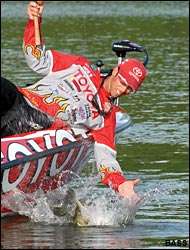
In an ideal world, tournament pros and weekend anglers alike would love to be able to fish a single lure and pattern to consistently catch bass. But on most days, keeping bass biting involves a multipronged approach.
That is particularly true of the postspawn season. And that makes it one of Michael Iaconelli's favorite times of the year.
It was prime time junk fishing season during the weather-wracked CITGO Bassmaster Elite Series tournament on Alabama's Lake Guntersville. Although some of the bass were still in prespawn and spawning modes, the postspawn was in full swing and the New Jersey pro used it to his advantage. His expertise with junk fishing paid off with 71 pounds, 13 ounces and paved the way to his fourth BASS tour-level victory.
"I love junk fishing," the former CITGO Bassmaster Classic champion says. "My boat this week looked like a tornado came through and hit it. Most days I had between eight and 15 rods on the deck.
"Junk fishing is a term that describes bass that are not locked into one pattern and one depth, so you throw everything but the kitchen sink to catch 'em. When you think about postspawn, think about what's happening. You've got fish that are on beds; you've got males that are guarding fry; you've got females that are on the first break; you've got females that are on the summer ledges. There are all those patterns out there, and none of them are super productive."
So the New Jersey pro decided fish a lot of depth zones and a lot of different baits. "Being instinctive is the key to doing this. A lot times when you're junk fishing, you pull into an area, put your trolling motor down and you look at what's ahead of you. You say, what's the best bait to throw to that tree? What's the best bait to throw on that weed break? What's the best bait to throw on that bridge piling? And they're all different baits."
In a performance that would have made legendary junkman Fred Sanford proud, Iaconelli utilized four different lures to collect five-bass limits of 16-12, 22-1, 17-13 and 15-3 on a mid-April week that experienced a wide range of weather conditions.
With the bass in the 69,100-acre lake divided into a last wave of spawners, a few prespawn bass and full-blow postspawn, Iaconelli devised a game plan that took advantage of all three behavioral modes.
The first was a sight fishing pattern for both shallow bedding bass and males guarding freshly hatched fry. For prespawn and postspawn bass, he concentrated on deeper (6 to 12 feet) water. His shallow effort centered around main lake pockets between Siebold and South Sauty creeks, while the deeper grassbeds were located in the mouth of Brown's Creek.
With his shallow pattern, Ike's lure choice early in the tournament was a Texas rigged 4-inch Berkley Beast creature bait. Near midday in the final round, he made a timely move to abandon the deeper pattern and return to the shallow area. This time, sensing that by the final round the bass in the shallows had been pressured, he changed to a tail-weighted, watermelon seed Berkley Power Noodle, lighter line and spinning tackle — a move that produced three key bass.
His deeper pattern involved ripping two different chartreuse/blue crankbaits through hydrilla and milfoil: a medium running Frenzy Diver for the 8- to 10-foot zone and a Rapala DT6 for shallower spots.
"I love picking different baits, going from 6-pound line on a spinning rod to 20-pound flipping line and everything in between. That's really my style of fishing, and it fell into place for me.
"I like figuring out the puzzle. I like patterning the fish with different lures. I love junk fishing."
The key to junking is selecting the lure that best covers the depth zone the bass are keying on, Ike emphasizes, as well as the bait that most closely emulates the forage.
"This is what I try to do in every tournament — let the fish make the decisions for you. One of the big things that you hear anglers say is 'How do you know when to change? How do you know when to pick up that rod?'
"A lot of times, it's not your mind telling you, it's the fish telling you. When I was out there deep, and two hours went past without having a bite (in the final round), it was those fish telling me to leave the deep water and go shallow. The biggest lesson for me this week is to be smart and pay attention to what fish tell you. If you're not getting bites, it's time to go; and when you get a bite, learn something from that bite."
Winning details
Michael Iaconelli
Elite Series Champion
Southern Challenge
Lake Guntersville
Lures: A 4-inch Berkley Beast creature bait (in a bluegill-colored pattern called Roadkill Camo); watermelon seed Berkley Power Noodle; medium-running Frenzy Diver and Rapala DT6 crankbaits (both were chartreuse with a blue back).
Tackle: Terminal: 3/8-ounce red Tru-Tungsten weight, 3/0 heavy-duty Tru Tungsten flipping hook. Creature bait: 12-pound-test Berkley Vanish Fluorocarbon, 6-6 medium-heavy Daiwa Light & Tough baitcast rod, Daiwa 2500 Series Advantage reel. Noodle: 8-pound fluorocarbon, 6-6 medium-action spinning rod and 2500 reel. Crankbaits: 12-pound-test Berkley Sensation line, 7-foot fiberglass cranking rod and 2500 reel. Amber-colored Cocoon sunglasses.
Technique: Sight fishing for both bedding bass and those guarding freshly hatched fry in shallow vegetation; ripping a crankbait through deeper (6 to 12 feet) water for prespawn and postspawn bass.
Purolator Big Bass
Albert Hudson, 8-07
"I was slow rolling a spinnerbait along grass humps in 4 to 6 feet of water in the Goose Pond area when the big bass hit. I was using a white 1/4-ounce War Eagle spinnerbait with tandem No. 2 silver and gold willowleaf blades, 20-pound-test SpiderWire Stealth braided line, 7-foot medium-heavy All Star rod and a Shimano Curado reel."
